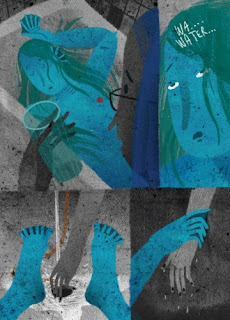s!, (formerly kus!), is the flagship anthology of kus!, the Latvian publisher that has a wide, international reach. Publishing in English, editors David Schilter and Sanita Muizniece have nonetheless always given each issue a heavily Baltic feel, and the tenth anniversary issue (#29) is a special celebration that focuses mostly on Latvia. I've said it before: Latvia is to comics as Lithuania is to basketball, meaning that these two states with small populations have a disproportionate amount of success and influence relative to their populations. Of course, all it takes to put a small press anthology is a lot of patience and determination, along with funding from the state culture foundation.
Most of the artists follow up on the celebration theme and do short stories about parties of various kinds. From Ana Vaivare's opening strip following a cat on the floor trying to get scraps from a table set for a feast Konig Lu Q's exploration of celebrations of not just commemorating booms and busts, but also causing them, there's the usual wide array of styles and visual approaches to be found. From a bright use of color from Vaivare and an open page layout to minimalist black and white and a standard grid, the anthology remains compelling throughout because no two strips look the same. The editors also made sure to alternate stylistic choices from one story to the next, such as Kaspar Grosev's swirling, almost abstract figures giving way to the over-the-top color and cartoonish monsters in Ernest and Andres Klaven's exploration of Cthulhu as a rejected slam poet. Speaking of elder gods, Reinis Peterson's red, yellow and orange-soaked silent saga has a huge boar sacrificed, a giant fire built, and a sickly green demonic figure rising out of the fire.
There's the joyous, brightly colored doodles of Davis Ozols, where happy blobs and humanoid shapes float around in rapt happiness. That's immediately followed by the unnerving "Dirty Pool", by Laura Kevins. A woman cleaning up after a party finds a friend hiding in the swimming pool in order to get away from a stalker. Next thing she knows, a chorus of "hey baby" and "aren't you going to say hello" comes from the bushes, as though they were surrounded by a pack of wolves. Staying in the pool is the only way to be safe, because "if they get wet they think they are crying--and vulnerability makes them dissolve". The humor is darkly accurate, as even the joking tone of the story is built on real-world experiences.
Other highlights include Elena Braslina's charming "The Dishes". Using a dense, scratchy style overlaid with key spot color, it tells the tale of a young woman who decides to clean a bathtub full of filthy dishes after a wild party. As she scrubs the dishes and more water winds up in the tub, she reveals a mermaid of sorts. In a neat bit of magical realism, the two escape together down the drain. The scratchy quality of her line, leaving all sorts of splatter on the page, was a perfect way of depicting the sheer amount of filth all over the place. The aquamarine skin of the woman in the tub breaks through all that splattered ink, and last panel was entirely that shade of blue-green.
Ruta Briede's "They Came" is a charming story, done in a clear green line, about a woman preparing a feast for the neighborhood cats. There's a deliberate, slow pace to this story that invites the reader to closely look at details and enjoy the unfolding events rather than worry about where they lead. Maija Kurseva's collage comics, where images are cut out of other images to form the people and furniture at a party. It's all laid over graph paper, giving it kind of an angular 80s music video aesthetic. It's the kind of piece that I love seeing in s!, as the editors are dedicated to presenting as wide a variety of visual approaches as possible. Finally, Martins Zutis' plays with the grid in an interesting way. He uses a 2 x 4 grid pattern and establishes the story on the first page, with each panel describing what is to come in the rest of the story, which is wordless. Each story unfolds a panel at a time per page; for example, the third panel down from the top on the left is "underground tea party". We see images of crystalline creatures slowly drinking tea. Each story unfolds separately, that is, until the "Volcano's first day of work" (with a mountain dressed in a business suit--a very clever visual pun) interferes when lava starts invading every other panel. It's one of many clever visual jokes as many of the mini-stories are celebrations in and of themselves.
Friday, July 6, 2018
Subscribe to:
Post Comments (Atom)







No comments:
Post a Comment